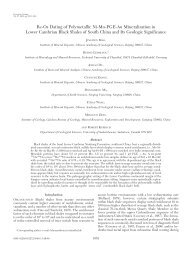MACROCRYSTALS OF Pt–Fe ALLOY FROM THE ... - RRuff
MACROCRYSTALS OF Pt–Fe ALLOY FROM THE ... - RRuff
MACROCRYSTALS OF Pt–Fe ALLOY FROM THE ... - RRuff
Create successful ePaper yourself
Turn your PDF publications into a flip-book with our unique Google optimized e-Paper software.
606 <strong>THE</strong> CANADIAN MINERALOGIST<br />
MgK, and AlK lines were used. The K line of oxygen<br />
and the YAG synthetic compound have been used<br />
as a standard for oxygen in the analysis of a bismuth<br />
oxide phase.<br />
Proton-induced X-ray emission (PIXE) analysis was<br />
done at the Heidelberg nuclear microprobe (Traxel et<br />
al. 1995) using incident protons at energies of 2.2 MeV<br />
and beam currents from 20 pA up to 300 pA. Calibration<br />
was done with pure elements and was checked with<br />
a number of international glass standards (Wallianos et<br />
al. 1997, Jochum et al. 2000). For data reduction, we<br />
used the GUPIX software (Maxwell et al. 1989, 1995).<br />
SAMPLE DESCRIPTION AND ANALYTICAL RESULTS<br />
Over the last two decades, the Far East Geological<br />
Institute has been actively participating in an investigation<br />
of the geology, geochemistry and mineralogy of the<br />
Kondyor deposit. A large amount of representative rocks<br />
and minerals of the Kondyor placer has been collected<br />
under the leadership of I.Ya. Nekrasov, formerly the director<br />
of the institute, in collaboration with researchers<br />
B.L. Zalishchak and V.P. Molchanov. The samples studied<br />
belong to that collection. We have chosen four alluvial<br />
euhedral crystals of <strong>Pt–Fe</strong> alloy about 2–4 mm<br />
across. They come from the Anomal’nyi Creek area<br />
(Fig. 2). The attributes of the crystals were first documented<br />
by scanning electron microcopy; polished<br />
sections were then prepared, and studied by ore microscopy<br />
and electron-microprobe analysis. In addition, a<br />
large number of xenomorphic <strong>Pt–Fe</strong> grains from a<br />
composite heavy-mineral concentrate were studied to<br />
compare their composition to that of the euhedral macrocrystals.<br />
Sample I<br />
Sample I is an irregular cube of 4.3 3.1 mm size.<br />
The crystal consists of <strong>Pt–Fe</strong> alloy with a composition<br />
of Pt 2.5 Fe (Table 1). Copper, nickel and tin occur as<br />
minor elements. No other platinum-group elements besides<br />
Pt are detectable by electron-microprobe analysis.<br />
With reconnaissance proton-microprobe analysis, we<br />
detected zinc, germanium and antimony in the 100–<br />
1,000 ppm range (Table 2). The crystal contains 154<br />
ppm palladium, 99 ppm rhodium, and 22 ppm ruthenium.<br />
The crystal contains several inclusions of chromian<br />
titanian magnetite, up to 0.9 mm in size, with up to 8<br />
wt.% TiO 2 and 3 wt.% CrO 2 (Table 3). The magnetite is<br />
altered along fractures to a titanite-like phase with a high<br />
chlorine content (2.2–7.9 wt.% Cl). The chlorine-rich<br />
rim is surrounded by perovskite (Table 4) and chlorite<br />
(Table 5). Chlorite is represented both by clinochlore<br />
and chamosite. A 10-m inclusion of fluorapatite was<br />
found inside a clinochlore rim (Table 4). Phlogopite is<br />
present as an inclusion inside of a grain of magnetite,<br />
surrounded by clinochlore.<br />
The <strong>Pt–Fe</strong> alloy crystal is rimmed by a complex and<br />
irregular gold-rich zone (locally up to 0.4 mm wide)<br />
with high contents of gold, copper, platinum, palladium,<br />
bismuth and tin. The main mineral phase in the inner<br />
part of the gold-rich rim is Pd–Pt-bearing tetraauricupride<br />
[(Au,Pt,Pd)Cu] (Table 6). The outer part of<br />
the rim is formed by Au–Ag alloy of Au 0.47 Ag 0.52 Cu 0.01<br />
composition as well as by small aggregates of very pure<br />
native gold in the outermost rim (Fig. 4, Table 6).<br />
There are flame-like composite aggregates of<br />
tatyanaite [(Pt,Pd,Cu) 3 Sn] – taimyrite [(Pd,Pt,Cu) 3 Sn]










